Must Try Turkish Meze Recipes for Food Lovers
Have you ever sat down at a table and been greeted by a colorful array of small plates, each offering a different burst of flavor, texture, and aroma? If you’ve dined in Turkey—or even just explored its cuisine you’ve likely encountered Turkish meze, a beloved tradition that turns simple ingredients into an unforgettable culinary experience.
More than just appetizers, meze is a way of life in Turkey. These vibrant small plates unite people, inviting conversation and connection over shared bites. But what exactly makes a meze dish stand out? Which ones should you try first if you’re new to the world of Turkish food meze?
Whether planning a trip to Turkey, expanding your cooking repertoire, or simply curious about new flavor profiles, this guide to Turkish meze dishes will walk you through the most iconic, delicious, and culturally rich options you won’t want to miss. From creamy yogurt blends to bold, spicy vegetable spreads, each dish tells a story, and you’re about to discover them all.
Haydari: Thick, Tangy, and Herb-Infused
If you’re a fan of bold, garlicky dips, Haydari will be your new obsession. Made with strained yogurt (often labneh), Haydari is thick, rich, and full of flavor. It’s seasoned with crushed garlic, dried mint, fresh dill, and a touch of salt, then drizzled with olive oil for a silky finish.

Why Haydari is a must-try:
-
Strong herbal notes balanced by creamy yogurt
-
Pairs beautifully with warm pita or crisp vegetables
-
A crowd favorite in both traditional and modern Turkish meze spreads.
Cacik: Cool, Crisp, and Refreshing
Cacik is Turkey’s answer to tzatziki but with its light, summery flair. It starts with yogurt thinned slightly with cold water or ice, then mixed with finely chopped cucumbers, garlic, and fresh mint. Served chilled, often with a few cubes of ice still floating, it’s the ultimate cooling dish on a warm day.

Why Cacik is a must-try:
-
Works as both a dip and a refreshing soup
-
Low-effort, high-reward: minimal ingredients, maximum flavor
-
A staple of homemade Turkish cuisine, especially in summer
Atom: Fiery Butter Meets Cool Yogurt
Looking for something a little unexpected? Atom is a meze that surprises in the best way. This dish begins with a base of thick yogurt spread across a plate. Then comes the magic: a sizzling sauce of butter and dried chili flakes (often Aleppo pepper), poured directly over the yogurt. The result? A flavor bomb of hot and cold, creamy and spicy, smooth and sharp.
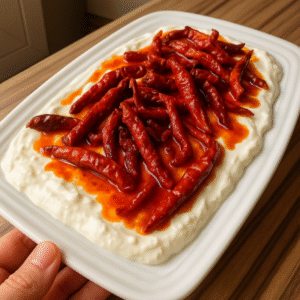
Why Atom is a must-try:
-
Perfect blend of richness and heat
-
Visually striking with vibrant red chili butter
-
Ideal for those who want a bold twist in their meze selection
Ezme: The Spicy, Zesty Kick Your Table Needs
Ezme is not for the timid it’s a punchy, finely chopped salad bursting with flavor. Made with ripe tomatoes, red and green peppers, onions, garlic, parsley, and a generous squeeze of lemon juice, it’s seasoned with pomegranate molasses and a kick of chili flakes.
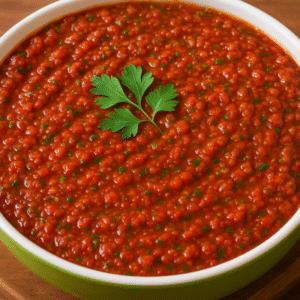
Why Ezme is a must-try:
-
It adds a fresh, spicy contrast to creamy or oily dishes
-
Works beautifully as a dip or a topping for grilled meat
-
Its sharp acidity balances out a meze spread with flair
Şakşuka: A Colorful Medley of Fried Vegetables
Şakşuka is comfort food disguised as a meze. At its core, it’s fried eggplant, zucchini, or potatoes (sometimes all three) topped with a rich tomato and garlic sauce. Served at room temperature, this dish is all about satisfying textures and savory depth.

Why Şakşuka is a must-try:
-
It’s hearty without being heavy
-
A perfect way to showcase summer vegetables
- Often enjoyed as a standalone dish in homemade Turkish meals
Barbunya Pilaki: Beans in Olive Oil, the Turkish Way
If you love slow-cooked comfort with a Mediterranean twist, Barbunya Pilaki is for you. This dish features borlotti beans simmered in olive oil with carrots, onions, tomatoes, and a hint of sugar. It’s typically served cold or at room temperature, with a squeeze of lemon to finish.
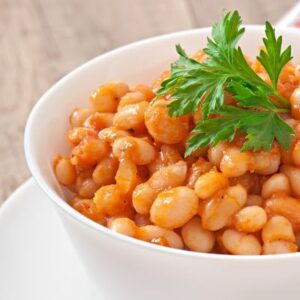
Why Barbunya Pilaki is a must-try:
-
Rich in plant-based protein and fiber
-
Light, flavorful, and incredibly satisfying
-
A great prep-ahead dish that only improves after a day in the fridge
Yaprak Sarma: Grape Leaves Wrapped Around Tradition
Yaprak Sarma is arguably one of the most iconic Turkish meze dishes. It features vine leaves tightly rolled around a fragrant filling of rice, pine nuts, currants, and a medley of herbs like dill, mint, and parsley. Often served cold and drizzled with olive oil and lemon juice, it’s a perfect balance of tangy, sweet, and savory.
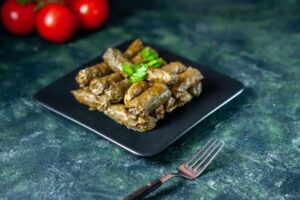
Why Yaprak Sarma is a must-try:
-
Labor-intensive but worth every roll
-
Vegan-friendly and packed with flavor
-
The perfect starter for festive or everyday meze spreads
Midye Dolma: The Ultimate Street-Meets-Gourmet Bite
If you’ve ever strolled along the Turkish coast, you’ve likely seen Midye Dolma stuffed mussels lined up at market stalls. These mussels are filled with aromatic spiced rice, sometimes with pine nuts and cinnamon, then served with a squeeze of fresh lemon. While it’s a popular street food, it also makes a luxurious addition to a homemade Turkish meze platter.
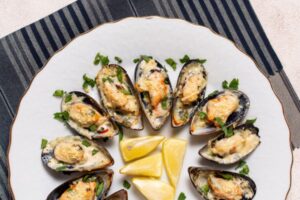
Why Midye Dolma is a must-try:
-
A unique blend of seafood and spice
-
Portable, snackable, and full of umami
-
Often served cold, making it a refreshing surprise on the meze table
Kabak Dolmasi: Zucchini with a Meze Twist
While dolma can refer to many stuffed vegetables, Kabak Dolmasi stuffed zucchini is a light and elegant take. Hollowed zucchinis are filled with a savory mix of rice, herbs, and sometimes minced meat, then simmered in a tomato-based sauce until tender.

Why Kabak Dolmasi is a must-try:
-
Delicate, mild flavor that pairs well with bold meze
-
Great warm or at room temperature
-
A flexible dish that can be made vegetarian or with meat
Fava: The Silky Bean Purée That Steals the Show
Despite its understated appearance, Fava is a quiet powerhouse. Made from dried broad beans (fava beans), this smooth purée is flavored with olive oil, onion, lemon juice, and a hint of dill. It’s chilled and sliced into thick slabs, then typically topped with more olive oil and fresh herbs.

Why Fava is a must-try:
-
Delicate, earthy flavor that pairs beautifully with sharp cheeses or pickles
-
High in plant-based protein and fiber
-
A refined choice among Turkish meze recipes for health-conscious eaters
Muhammara: Spicy, Nutty, and Completely Addictive
If you love bold dips, Muhammara is your meze soulmate. This vibrant red pepper spread hails from southeastern Turkey and is made from roasted red peppers, walnuts, breadcrumbs, garlic, olive oil, and a dash of pomegranate molasses. It’s slightly spicy, a bit sweet, and deeply savory.

Why Muhammara is a must-try:
-
Complex flavor profile—smoky, spicy, tangy, and nutty all in one
-
A fantastic alternative to hummus or baba ghanoush
-
Adds a colorful punch to any Turkish meze dishes spread
Patlican Salatasi: Smoky Eggplant at Its Best
Roasted eggplant is a cornerstone of Turkish cuisine, and Patlican Salatasi is a brilliant way to highlight it. This salad blends smoky roasted eggplant with olive oil, lemon juice, garlic, and sometimes green peppers or yogurt, depending on the region.

Why Patlican Salatasiis a must-try:
-
Rich, velvety texture with a pleasantly smoky taste
-
A perfect complement to meats, grains, or other vegetables
-
Light yet satisfying—a staple of summer meze spreads
Lakerda: Salt-Cured Elegance from the Aegean
Often referred to as the “Turkish sashimi,” Lakerda is a delicacy made from boneless bonito (a type of tuna), cured in brine and olive oil. It’s traditionally served cold, thinly sliced, and garnished with raw onions, lemon wedges, and a drizzle of olive oil.
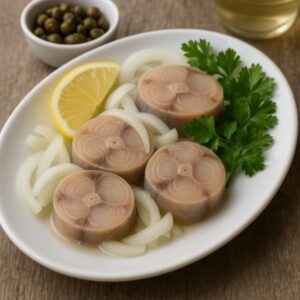
Why Lakerda is a must-try:
-
Pure, clean flavors that highlight the fish’s natural richness
-
A cold starter with serious depth and cultural heritage
-
A prized specialty, especially in coastal cities like Istanbul and Izmir
Kalamar Tava: Crispy Fried Calamari, Turkish-Style
Crispy on the outside, tender on the inside Kalamar Tava (fried calamari) is a crowd-pleasing meze that’s hard to resist. Sliced calamari rings are lightly coated in flour and fried until golden, then served with a side of garlic-yogurt or tartar-style dipping sauce.

Why Kalamar Tava a must-try:
-
Quick to prepare, yet full of flavor and crunch
-
A warm meze that contrasts beautifully with cold spreads
-
Universally loved even among seafood skeptics!
Hamsi Tava: Anchovies the Turkish Way
Don’t let the word “anchovy” scare you off Hamsi Tava is something entirely different from the salty fillets you may be used to. In this dish, fresh Black Sea anchovies are lightly coated in cornmeal and pan-fried whole, resulting in crispy, delicate fish that are best enjoyed hot and with your hands.

Why Hamsi Tava a must-try:
-
A favorite in the Black Sea region, especially in winter
-
Crunchy on the outside, moist on the inside
-
A perfect choice for seafood lovers looking to explore authentic Turkish meze recipes
FAQs About Turkish Meze
What is Turkish meze?
Turkish meze refers to a wide variety of small dishes typically served before the main course, especially in social settings like long dinners or gatherings. They include dips, salads, grilled or marinated vegetables, seafood, and more often shared and enjoyed slowly with drinks like rakı. Meze is about variety, balance, and creating a table full of conversation and flavor.
How to make Turkish meze?
Making Turkish meze dishes at home is easier than you might think. Many recipes are made with fresh, accessible ingredients like yogurt, olive oil, eggplant, beans, herbs, and lemon. Start with simple dishes like Haydari (herbed yogurt dip), Şakşuka (fried eggplant with tomato sauce), or Ezme (spicy tomato salad). The key is to focus on balance—pair creamy with spicy, hot with cold, and bold with mild.
Is Meze Greek or Turkish?
Meze is both! The tradition of meze exists across the Eastern Mediterranean and Middle East, including Turkey, Greece, Lebanon, and beyond. While the word meze comes from Persian, each culture has developed its versions. Turkish meze recipes have a distinct style, often featuring ingredients like yogurt, olive oil, fresh herbs, and seasonal vegetables, along with seafood and legumes.
What does meze mean in Turkish?
In Turkish, meze (pronounced “meh-zeh”) refers to small, flavorful dishes served to complement drinks or kick off a meal. It’s more than just food—it’s a cultural ritual. Meze invites sharing, tasting, and slowing down to enjoy both the flavors and the company.



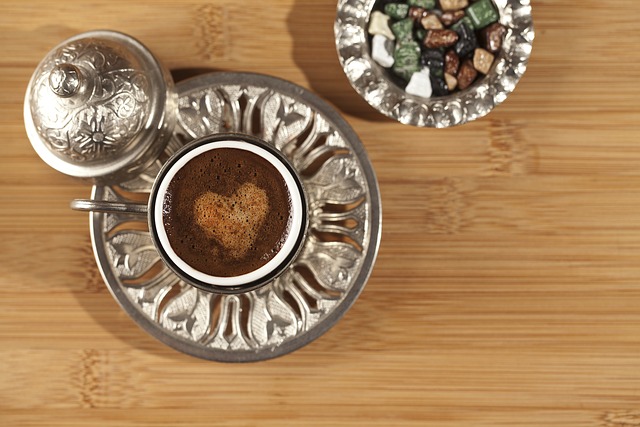
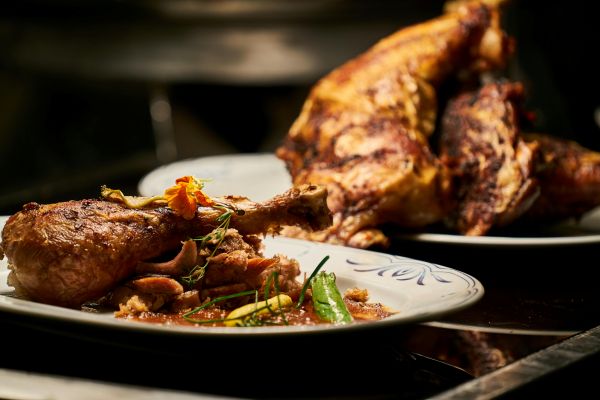



Regards for this post, I am a big fan of this site would like to continue updated.
I really appreciate this post. I have been looking everywhere for this! Thank goodness I found it on Bing. You have made my day! Thanks again!
Along with everything that seems to be developing within this specific subject material, your viewpoints are quite stimulating. Nevertheless, I am sorry, because I can not give credence to your entire strategy, all be it exhilarating none the less. It appears to everybody that your opinions are generally not entirely justified and in fact you are your self not completely convinced of your assertion. In any event I did enjoy examining it.